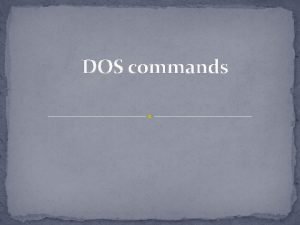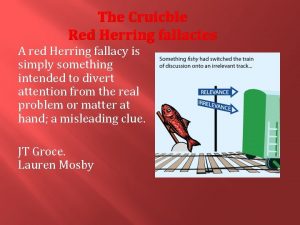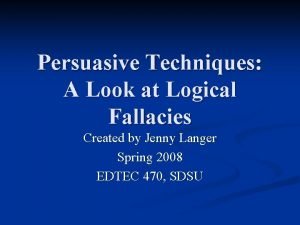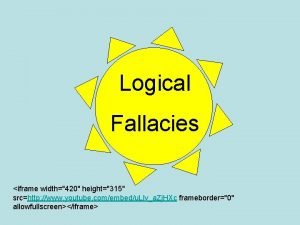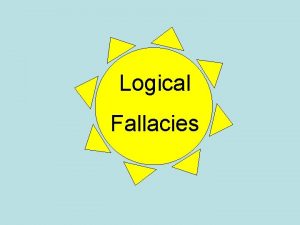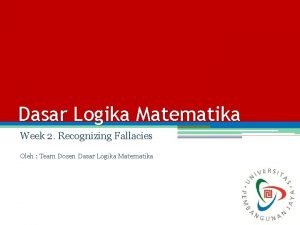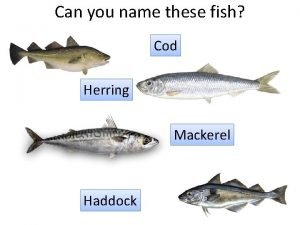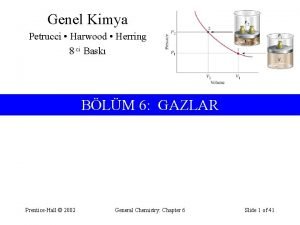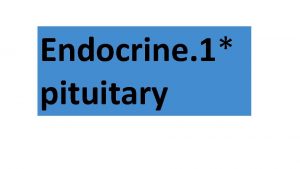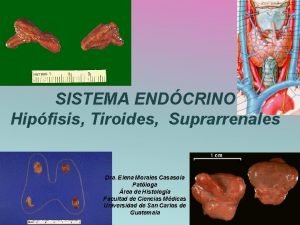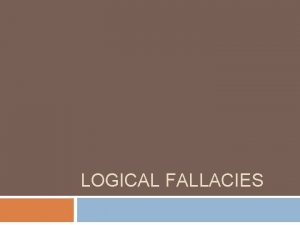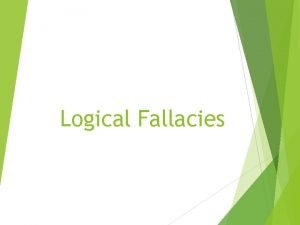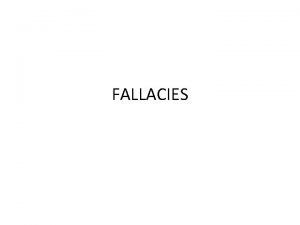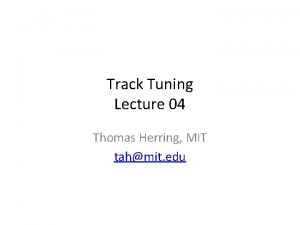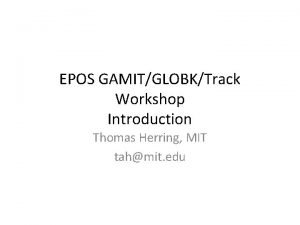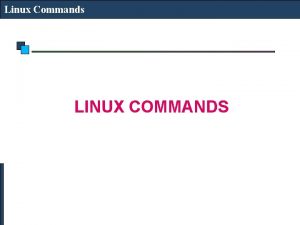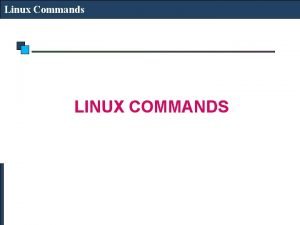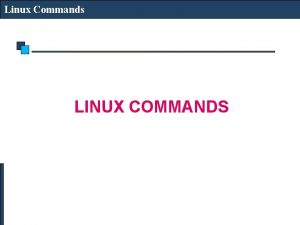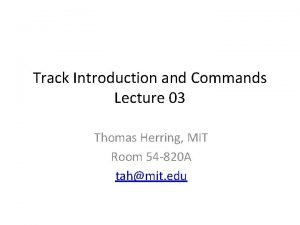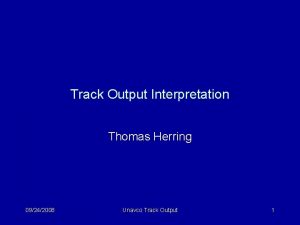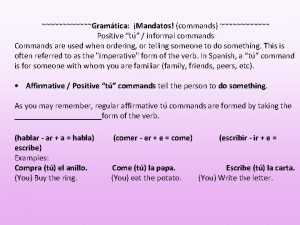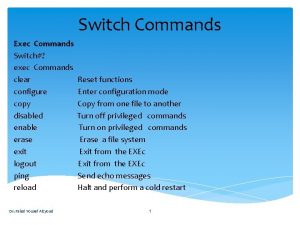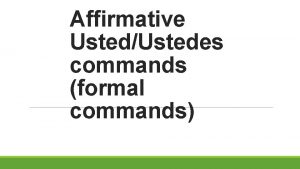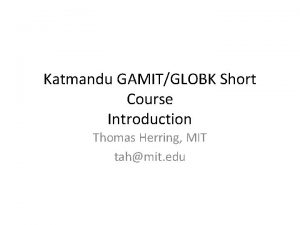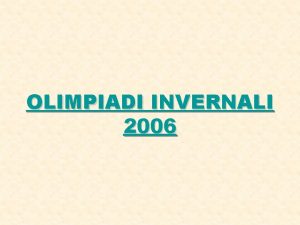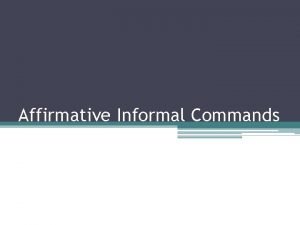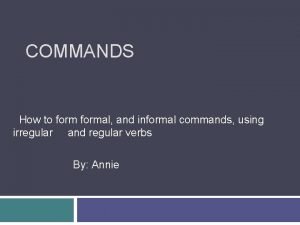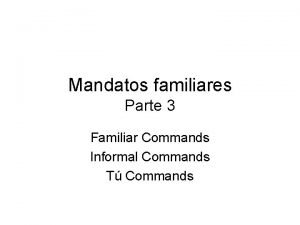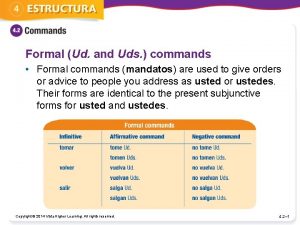Track Short Course Track RT commands Thomas Herring





























- Slides: 29

Track Short Course: Track. RT commands Thomas Herring, MIT Room 54 -820 A tah@mit. edu

Track. RT/Track. RTr commands • Track. RT and Track. RTr share many commands in common with track but there are some additional commands and some classes of commands that operate differently due to the real-time nature of the processing. 04/27/2011 Track Short Course: Track. RT commands 2

Minimum commands in command file SP 3_DIR : (unless sp 3 files are in the current directory) SITE_POS: Site positions must be given for every site to be processed. (Real time streams do not contain positions (unlike rinex headers in track). SITE_STATS: To set the apriori sigma and process noise for the sites. NOTE: The reference site position should be set to zero for the apriori sigma and process noise. Typical site_stats would be with cit 1 as the reference site. (If reference not set to zero, all site positions estimated). site_stats all 0. 1 0. 025 cit 1 0. 0 0. 0 ATM_STATS: By default atmospheric delays are not estimated, and normally these should be. Normally the reference site is set to zero when site separations are less the 500 -1000 km. Typical atm_stats command would be atm_stats all 0. 20 0. 00010 0. 000 ! Unit m/sqrt(sec) -> 0. 0001 = 0. 03 m/sqrt(day) cit 1 0. 00000 04/27/2011 Track Short Course: Track. RT commands 3

Also often needed commands If mixed antenna and receiver types are used ANTE_OFF: To specify the antenna heights and types and receiver types ANTMOD_FILE: Must be given to get the antenna phase center models RCV_TYPE: Needed for mixed receiver types (entry can be specified in ANTE_OFF also and this command would not be needed). DCB_FILE: Up to date, data code bias (DCB) file (part of GAMIT ftp area). Including UPDATE_FILE is useful so that track. RT can be controlled on the fly. 04/27/2011 Track Short Course: Track. RT commands 4

Input/output commands @ SP 3_DIR <Directory> <center> <Directory> -- Directory where sp 3 files are stored <center> -- Center for orbits (default igs, igr and igu also tested) 04/27/2011 Track Short Course: Track. RT commands 5

IO commands @ POS_ROOT <root> <duration> Set the root part of the name for the outout files. <root> Root part of name. When ? included in the <root>, the ? is replaced with the -n string. <duration> Duration of data in each file. The designations of d, h, or m may be used to specify the units of days, hours, minutes. Default is d. The position file names take the form: (see commands below) <root>. <outtype>. <site>. <start time>. <datatype> The resolution of the <start time> which is modulo the output interval depends on the output duration. For output durations greater than or equal to 1 -day, the time is given as YYYYMMDD. For intervals shorter than 1 -day, it is YYYYMMDD: HHMN. Minimum output interval is 1 minute. 04/27/2011 Track Short Course: Track. RT commands 6

IO commands @ SUM_FILE <root> Sets the root part of the summary file name. Using ? in the name with be replaced by the -n string. (Default if command is not given is track. RT or the -n string when -n used). File names are time tagged according to the pos_root output interval. 04/27/2011 Track Short Course: Track. RT commands 7

IO commands @ CSV_ROOT <root> Set the root part of the name for comma separated values (CSV) output file. These files are used for Am. Charts web plots. @ DCB_FILE <file name> Set the name of the data-code-bias (DCB) file. This file is part of the GAMIT tables directory and should be updated regularly. It is used to remove biases in the Melbourne-Wubbena widelanes. The receiver type can be specified with the RCV_TYPE or ANTE_OFF commands. 04/27/2011 Track Short Course: Track. RT commands 8

IO commands @ ANTMOD_FILE <file name> Sets the name of a standard IGS antex file with phase center models for the GPS ground antennas. Antenna types at specific sites are given with the ANTE_OFF command. This command my be used multiple times for site specific model with new models replacing previously read ones. @ UPDATE_FILE <file name> Allows new track. RT commands to be issued during a run. Once the file is read it needs to be deleted before the track. RT will re-read it. File is only read if it exists. NOTE: File should be removed before track. RT is run or else it will be read when the command file is read (ie. , it will overwrite the commands in the command file. 04/27/2011 Track Short Course: Track. RT commands 9

IO commands @ OUT_TYPE <NEU+GEOD+XYZ+DHU> Specifies types of output coordinates. All types can specified in a single string with no spaces. The types are NEU -- North, East, Up differences from the reference site or from the coordinates given in the REF_NEU command. GEOD -- Geodetic latitude, longitude and height (in the GEOD format, the total atmosheric delay is given, while in the other formats the adjustment to the apriori delay is given). XYZ -- Cartersian XYZ coordinates DHU -- Delta horizontal and Up coordinates from the apriori coordinates of each site (default output type) @ OUT_SIG_LIMIT <sigma (m)> Sets the maximum sigma of a position estimate for it to be output. If pseudorange data types are used, the default value of 1 m needs to increased to 10 -100 meters. 04/27/2011 Track Short Course: Track. RT commands 10

Analysis commands @ DATA_NOISE <L 1 (m)> <L 2 (m)> <P 1 (m)> <P 2 (m)> <Elev Weight> [PRN] Same as track @ DATA_TYPE <type> Same as track (L 1 only should be possible but not checked). @ USE_GPTGMF Same as track (recommended for all runs) @ SITE_POS @ Site <X (m)> <Y (m)> <Z (m)> <Vx (m)> <Vy (m)> <Vz (m)> <Epoch (yrs)> Same as track 04/27/2011 Track Short Course: Track. RT commands 11

Analysis commands @ ANTE_OFF @ Site <ARP d. N (m)> <ARP d. E (m)> <ARP d. U (m)> <Antenna Name> <Receiver Code> Specifies the type of antenna and its position of antenna reference point (ARP) at each site. The antenna name including radome should be specified with the official IGS name for a standard ANTEX file or with a unique name that appears in the ANTEX file for site specific calibrations. (Note: There is one additional character in the station. info long antenna and this extra character before the radome name must be removed. The antenna name and radome can be copied directly from the rinex file if present. One more ANTEX files must be specified with the ANTMOD_FILE command for the antenna names to be useful. The receiver type DCB code can be optionally specified here as well (See RCV_TYPE command). 04/27/2011 Track Short Course: Track. RT commands 12

Analysis commands @ RCV_TYPE @ Site <Receiver code N/P/C> Specifies the type of data-code-bias (DCB) correction needed for the receiver. Code specifies the type of L 1 and L 2 ranges being measures. The choices are P -- Pcode, C -- C/A and N C/A with cross correlation for L 2 range. The codes can be found in gamit/tables/rcvant. dat. These codes can also be given in the ante_off command. An up-to-date DCB_FILE command must be used to specify the DCB biases. The files are available from the MIT ftp site and update once per month. 04/27/2011 Track Short Course: Track. RT commands 13

Analysis commands @ SITE_STATS @ Site <Apriori Sigmas in XYZ (m)> <RW noises in XYZ (m/sqrt(sec))> Same as track except units here are per sqrt(seconds) always (not time_unit command here). @ ATM_STATS @ Site <Apriori Zenith delay sigma> <RW noise in Zenith delay> <RW d. H/dt noise> Same as track with. Track second as time unit. 04/27/2011 Short Course: Track. RT 14 commands

Ambiguity Resolution • track. RT uses a combination of the Melbourne-Wubbena widelane (MW-WL), the extra widelane (EX-WL) and the floating point estimates of the ionospheric free ambiguity (LC) to resolve integer ambiguities. • If we denote the number of integer cycle ambiguities at L 1 and L 2 by N 1 and N 2, • MW-WL is an estimate of N 1 -N 2 based on phase and range data; • EX-WL = N 1 - f 1/f 2 N 2 and is an integer for L 1 cycles, but 1. 283 N 2 for L 2 cycles; • LC = 2. 546 N 1 - 1. 984 N 2. • The EX-WL is unaffected by geometric ranges changes, but does depend on the ionospheric delay. • For short baselines, the EX-WL should be near zero for correct choices of N 1 and N 2. • The LC residual should also be near zero when N 1 and N 2 are correct. 04/27/2011 Track Short Course: Track. RT commands 15

Ambiguity Resolution • The problem in ambiguity resolution is that different choices of N 1 and N 2 can make different linear combinations small. • For example, errors in N 1 and N 2 of 3 and 4 cycles will change LC by 0. 298 cycles (56. 6 mm), MW-WL by 1 cycle and EX-WL by 2. 132 cycles (405 mm). • On long baselines, at low elevation angles, ionospheric delays of 400 mm (2 cycles) are common. • The most common error is a N 1=N 2=1 cycle error. For this combination, the MW-WL is unaffected and LC changes by 0. 562 cyc (107 mm) and EX-WL by 0. 283 cyc (54 mm). Even on relative short baselines, 54 mm ionospheric delays are common 04/27/2011 Track Short Course: Track. RT commands 16

Commands to control ambiguity resolution @ AMB_SET <Rel. Rank> <Float. Sigma (2)> <MWWL Fact> <EXWL Fact> <Min Amb. Sig> <Max. Chi> Sets parameters for ambiguity resolution. The input parameters are: <Rel. Rank> <WL min> Minumum of values need to allow bias fixing <WL av. N> Maximum number to be used in computing sigma of mean MW-WL <Float. Sigma (2)> Minimum sigma for LC and MW-WL for ambiguity fixing <MWWL Fact> Weighting factor for MW-WL in chi**2 <EXWL Fact> Weighting factor for extra-wide lange <Min Amb. Sig> Minimum sigma to assigned to float estimates of ambiguities. <Max. Chi> Max chi**2 value allowed for ambiguity to be resolved. This command is similar to the float_type command in track 04/27/2011 Track Short Course: Track. RT commands 17

Commands to control ambiguity resolution @ EXWL_SET <Jump> <Min Sigma> <Scale> <Elev Fact> <Jump> -- magnitude of jump in EX-WL to have cycle slip added (default 0. 10) <Min Sigma> -- minimum sigma for mean ex-wl (cycles, default 0. 02 cycles) <Scale> -- Scaling factor for length. Scale 0. 1 results in 0. 1 cycles over 100 km (default) <Elev Factor> -- Elevation angle factor that increases sigma as (1 + factor/sin(elev)) This command is set tolerances for adding a new cycle slip to the processing. The length dependent term of different length baselines in the processing. 04/27/2011 Track Short Course: Track. RT commands 18

Commands to control ambiguity resolution @ MWWL_SET <Jump> <Min Sigma> <Max Averaging number> <Min number> <Jump> -- magnitude of jump in MW-WL to have cycle slip added (default 5. 0) <Min Sigma> -- minimum sigma for mean MW-WL (cycles, default 0. 10 cycles) <Max Averaging number> -- Maximum number of values to use to compute mean sigma <Min number> -- Minimum number needed to resolve ambiguity Cycle slip detection based on the MW-WL lines 04/27/2011 Track Short Course: Track. RT commands 19

Commands to control ambiguity resolution @ DD_SET <Jump (cycle)> <Min Number> Sets parameters for double difference processing. <Jump (cycle)> -- Magnitude of jump in double differences on bias fixed data that will introduce a cycle slip <Min Number> -- Minimum number of double differences for an epoch to be processed. (If too few double differences than errors in the data can not be detected and this can cause large position errors, default of 4 double differences allows redundancy). 04/27/2011 Track Short Course: Track. RT commands 20

Commands to control ambiguity resolution @ RMS_EDIT_TOL <n-sigma Tolerance> <min sigma> <Reset number> <n-sigma tolerance> is an n-sigma condition where sigma is based on data noise model. <min sigma> Minimum phase sigma to use so that no phase residual less than <min sigma>*<n-sigma tolerance> are deleted <Reset number> number of sequential delete data, before ambiguity and cycle slips are reset (assumed missed cycle slip). This a post-fit editing option to remove bad data. Data epoch is re-processed if data are deleted. 04/27/2011 Track Short Course: Track. RT commands 21

Testing and Evaluation @ STATUS <type> <# epoch> Writes status information to the current summary file at <# epoch> intervals The types of reports are given by "type" P -- Parameter estimates A -- Ambiguity resolution report (shows resolved and unresolved) W -- Widelanes (Melbourne-Wubbena and Extra-widelanes) R -- Postfit residuals are current epoch C -- Report current A and W entries only type PAWR will output all reports. 04/27/2011 Track Short Course: Track. RT commands 22

Testing and Evalutions @ NUM_EPOCHS <number> is the number of epochs of data to be processed before stopping. When short duration files are output (POS_ROOT command) the number of epochs may not be reached because the epoch counter is reset with each new file. @ START_TIME <yy mm dd hh min sec. > Used to set the start time. Useful with track. RTr to have the processing start at the same time as the realtime stream. 04/27/2011 Track Short Course: Track. RT commands 23

Testing and Evaluation @ DEBUG <Up to 10 epoch numbers in pairs> Sets which epochs will report detailed debug and status information (see STATUS command as well). The pairs are used as: 1, 2 -- Mostly model information. Useful if data are generating large residuals 3, 4 -- Parameter estimates, widelanes, residuals 5, 6 -- One-way OMC and single differences 7, 8 -- Not Used 9, 10 -- When 9 is non-zero, antenna model and SP 3 information is output. This command is often used in the update_file command file. 04/27/2011 Track Short Course: Track. RT commands 24

Testing and Evaluation @ RESET <ALL/list of sites> Reset command. Resets the filter state vector and resolved ambiguities for a list of sites or ALL sites (generally used in the update_file to fix problems) @ EXCLUDE_SVS <list of PRN numbers to be excluded> Excludes satellites from being processed. Useful when a satellite is not in an SP 3 file or not available during the times there are data. Example: exclude_svs 26 22 13 04/27/2011 Track Short Course: Track. RT commands 25

Testing and Evalution @ UPDATE_FILE <file name> Allows new track. RT commands to be issued during a run. Once the file is read it needs to be deleted before the track. RT will re-read it. File is only read if it exists. NOTE: File should be removed before track. RT is run or else it will be read when the command file is read (ie. , it will overwrite the commands in the command file. Generally, we keep a file of a different name and then copy it to the <file name> here when we want it to be used. 04/27/2011 Track Short Course: Track. RT commands 26

Lines written to summary file • Cycle slip detection: CSLIP Ep 540 Site THMG G 29 DMW-WL/Tol DEX-WL/Tol 1. 78 0. 20 cyc, Elev 10. 00 deg 4. 31 4. 00 • This case show a slip detected with MW-WL and EX-WL jumps. The values of the jump and the current tolerance are reported. • Double difference residual slip CSLIP Ep 12 Site P 496 G 15 DD RESID 23. 45 deg 04/27/2011 -4. 80 Tol 0. 50 cyc, Elev Track Short Course: Track. RT commands 27

Lines written to summary file • Resolve ambiguities: When ambiguities are resolved, three lines are output giving the statistics (lines are wrapped here) • AMBFIX WMAP PRN 29 EP 599 Rel. Rank 101. 76 FC ------ d. L 12 4 3 Dchi 6. 54 691. 02 AMB 36 • AMBWLS WMAP PRN 29 EP 599 RG 133 599 FX 3 i. L 12 0 0 Means -0. 16 -0. 05 RMS 0. 74 0. 06 # 467 e. N 12 -0. 54 -0. 38 Az. El 274. 32 12. 35 • AMBCON WMAP PRN 29 EP 599 NCont 3 MW Res -0. 159 0. 185 Chi 2 0. 74 EX Res -0. 051 0. 068 Chi 2 0. 55 LC Res -0. 046 0. 020 Chi 2 5. 25 • Help file explains entries: RG is range of data used. 04/27/2011 Track Short Course: Track. RT commands 28

Other outputs • Other outputs from the STATUS command are explained in the help file • Lines are too long to effectively show here but in the tutorial session we can look at the results. • We now look at some results generated during the talk and from earlier track. RT runs 04/27/2011 Track Short Course: Track. RT commands 29
 Long and short
Long and short What is internal commands
What is internal commands Red herring logical fallacy
Red herring logical fallacy Red herring fallacy
Red herring fallacy Red herring fallacy
Red herring fallacy The non sequitur fallacy
The non sequitur fallacy Red herring definition fallacy
Red herring definition fallacy Red herring fallacy
Red herring fallacy Hasty generalization contoh
Hasty generalization contoh Cod vs herring
Cod vs herring Red herring fallacy in the crucible
Red herring fallacy in the crucible Hypophysis cerebri
Hypophysis cerebri Kimya gaz kanunları
Kimya gaz kanunları Tissue biology
Tissue biology Herring bodies pars nervosa
Herring bodies pars nervosa Red herring
Red herring Mamotropa
Mamotropa Red herring examples
Red herring examples Post hoc ergo propter hoc fallacy
Post hoc ergo propter hoc fallacy Red herring meaning
Red herring meaning Ecological fallacy definition
Ecological fallacy definition Tom herring mit
Tom herring mit What types of propaganda are used in animal farm
What types of propaganda are used in animal farm Tahmit
Tahmit Http www mybigcampus com
Http www mybigcampus com Forensic pathologist vs forensic anthropologist
Forensic pathologist vs forensic anthropologist T junction in english bond
T junction in english bond Course number and title
Course number and title Course interne course externe
Course interne course externe Totem thomas king theme
Totem thomas king theme

